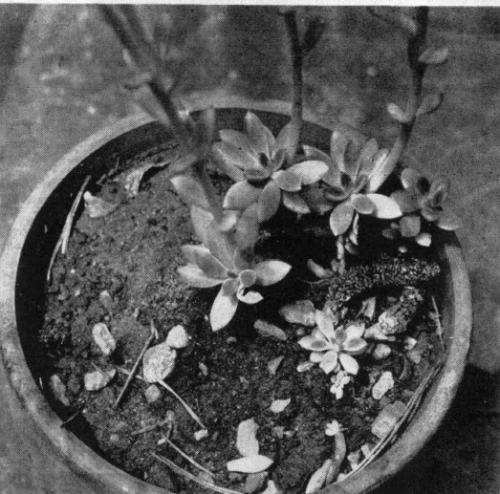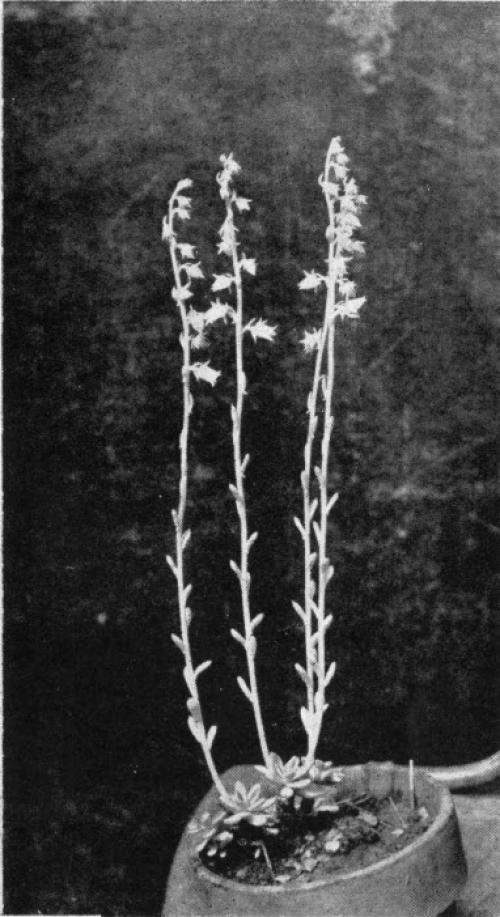BALLSII Walther, 1958 (engl./ fr.)
ECHEVERIA BALLSII DOES NOT OCCUR IN SOUTH AMERICA, IT IS NOT A COLOMBIAN PLANT.
ACCORDINGLY THE TISSUE-CULTURE "ECHEVERIA BALLSII" CANNOT POSSIBLY BE THE CORRECT SPECIES.
See Notes below.
First Description by E. Walther in Cactus and Succulent Journal US 30(2): 44. 1958
(from a plant cultivated in Strybing Arboretum) :
Plant glabrous.
Stem evident, but short, several from one base.
Leaves thick, turgid above, oblong-obovate, acutish, to 35 mm long, about 10 mm broad, narrowed to less than 5 mm at base, yellowish-green.
Inflorescences one or two to each rosette, 25 to 30 cm tall, equilaterally racemose but sometimes unilateral from one-sided lighting, peduncle erect, lower bracts ascending to spreading, narrowly oblong-obovate, to 15 mm long, flowers about 10, nodding, pedicels to 10 mm long, their bractlets slender, to 5 mm long.
Flowers : Sepals subequal, longest to 8 mm long, flat, acuminate, ascending, corolla nearly straight, to 12 mm long, about 8 mm in diameter near base, peach-red to scarlet, pale-yellow in shade, petals spreading at apex, inside with basal hollow.
Link to a summary of the above description in English and French.
Note :
1. A critical examination of Walther's text (Echeveria, 359-361, 1972) about E. ballsii has produced the following result :
The plant Walther described as E. ballsii originated in his collection grown at the Strybing Arboretum, Golden Gate Park, San Francisco, not in Colombia. He thought he would describe a plant he had received in 1939 from E.K. Balls, collected near Siachoque, dept. Boyaca, Colombia (Balls' nr 7587) and wanted to name it for him. However evidently he had mixed-up labels - not a surprise in view of the mess in his collection - with the result that a plant definitely not collected by E.K Balls was named for him ….
Balls had described 7587 as a plant with a 30 cm tall stem, with terminal, rather (longwise) rounded rosettes with small pointed leaves, and flowers rather short rounded bells, scarlet and yellow.
What Walther described however was a plant with "stems evident, but short", "leaves oblong-obovate" and a "corolla nearly straight" - clearly these are two different plants. Why he did not notice this wrong identification himself is incomprehensible. However, it would not have made things any better if Walther had described the correct plant, namely the one he had received from Balls with the number 7587, instead of the wrong one, because this one had already been identified as Echeveria columbiana Poell, i.e. was not a new species and therefore did not need a new name.
Walther's E. ballsii has no origin in the wild and it may even have been a hybrid. As the photos below show, it looks rather pitiful …. whether it still exists somewhere is unknown.
In any case, the name E. ballsii Walther belongs to the plant without known origin and cannot be used for plants occurring in Colombia or other South American states.
2. Accordingly the plant sold by Pilbeam and others, said to be produced by micro-propagation (Pilbeam, The genus Echeveria, p.54, 2008), collected 20 km west of Bogota, Colombia, cannot possibly be E. ballsii Walther.
3. The photos on www.crassulaceae.com of a plant in cultivation are by far not correct.


Photos published with the First Description in Cactus and Succulent Journal US 30(2): 45. 1958.